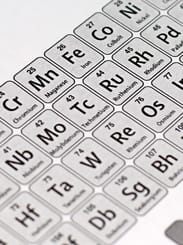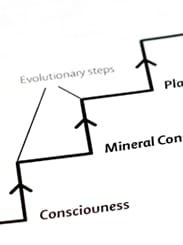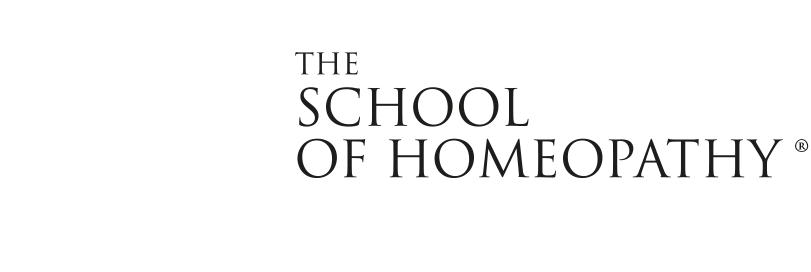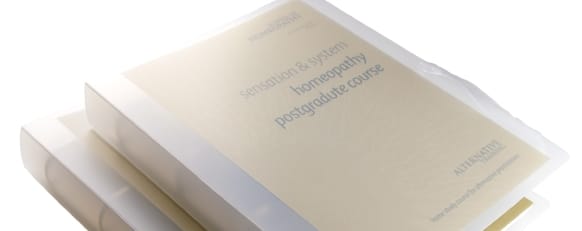

.jpg)

Homeopathy Postgraduate
Sensation & System
Course Content
Full details of each unit are given below the brief outline, with the aims, content and learning outcomes:
Unit 1 : Vital sensation
The Totality, Introducing the Vital Sensation, Case Receiving to the Sensation Level, The Levels
Unit 2 : Kingdoms
The Need for Classification in the Homeopathic Materia Medica, Kingdom Classification, Finding the Kingdom in a Case, Mineral Kingdom, The Mineral Kingdom in Homeopathy, Plant Kingdom, The Plant Kingdom in Homeopathy, Animal Kingdom, The Animal Kingdom in Homeopathy, Other Kingdoms
Unit 3 : Minerals
An Overview of the Elements of the Periodic Table,
The Periodic Table in Homeopathy, Combined Elements : Salts and Compounds
Unit 4 : Miasms revisited
The Original Concept of the Miasm, A New Emphasis in Perceiving the Miasm, The 10 Miasms, An Overview of the Miasms in Modern Homeopathy
Unit 5 : Plants
The Plant Kingdom – Sensitivity and Reactivity, How Plants Adapt, Looking at Individual Plant Adaptations, Plant Evolution, Plant Families, How to Use the Sensation Method for Plants in a Case
Unit 6 : Animals
Animal Issues: Predator & Prey, Animal Issues: Family Life, Animal Evolution, Animal Groups, Other Animal Groupings, How Will you Know When an ‘Animal’ Has Come Into your Consulting Room?, Some Pitfalls When Looking at the Animal Kingdom
Unit 7 : Integrated approach
The Task of the Homeopath, Seeing the Patient 1 - Exploration, Seeing the Patient 2 - Evaluating, An Integrated Approach to Evaluating the Patient, Seeing the Remedy - Discovering, Matching Patient with Remedy - Defining, Assisting the Action of the Remedy
Unit 1 : Vital Sensation
Aims
This unit aims to introduce you to the concept of the vital sensation and seven levels of consciousness as described by Rajan Sankaran. You will study Sankaran’s Sensation Method and how to use different techniques to relate his theory to case-taking and analysis. You will explore each of the seven levels at which a patient may communicate their symptoms and how to relate these to the Mappa Mundi. In addition you will study a further five remedies from the homeopathic materia medica and complete three case analyses.
Learning Outcomes
At the end of this unit you will be able to:
- Explain the term ‘Vital Sensation’
- Relate the vital sensation to the seven levels
- Identify each of the seven levels in relation to how a patient communicates
- Illustrate the seven levels on a Mappa Mundi
- Describe the way in which people may express different levels in daily conversation
- Identify the levels in homeopathic remedies
- Analyse a group of remedies and place them on the mappa mundi
- Analyse case examples using the Mappa Mundi and Sankaran’s sensation method
Content
Recordings
1. Introduction
2. Philosophy
2.1 The Totality
2.2 Introducing the Vital Sensation
What Makes a Sensation the Vital Sensation
The Vital Sensation in a Historical Context
2.3 Case-receiving to the Sensation Level
Perceiving the “Non human song”
The Chief Complaint
There is Nothing Out There Other Than Oneself
Translating the Patient’s Language to the Repertory
Asking the Same Thing Over and Over Again
Hand Gestures
2.4 The Levels
The Levels and Potency
The Levels as an Indicator of Health
Connecting the Levels with Mappa Mundi
2.5 Summary
3. Materia Medica
Cicuta Virosa, Colchicum, Crocus, Lilium Tigrinum and Veratrum Album
4. Cases
Andrea – assignment case
Hilary – assignment case
Jean – assignment case
Jane – example case
Martine – example case
5. Self-Assessment Questions
6. Assignments
6.1 Philosophy
U1SQ1/g: Vital Sensation & Levels
6.2 Philosophy in Practice
U1SQ2/g: Levels in Conversation
6.3 Materia Medica
U1SQ3/g: Lili Tig & Liliflorae
U1SQ4/g: Cicuta Virosa
U1SQ5/g: Levels in Nat Mur
6.4 Case Analysis
U1SQ6/g: Andrea using Sankaran Approach
U1SQ7/g: Jean using Sensation Methods
6.5 Personal & Professional Development
6.6 Sending your Assignments
7. Figures
Unit 2 : Kingdoms
Aims
This unit aims to expand your knowledge of the Sensation Method and introduce you to the different kingdoms in homeopathy. You will be taught how to differentiate between kingdoms in your analysis of a patient, and how to identify a remedy belonging to a particular kingdom classification. You will study three remedies and further develop you case analysis skills through continued case work.
Learning Outcomes
At the end of this unit you will be able to:
- Explain the classification of the kingdoms in homeopathy
- Identify remedies that belong to each kingdom
- Identify different statements from patients as belonging to a particular kingdom
- Outline characteristics of the three main kingdoms in relation to human behaviour
- Describe the differences between some remedies in different kingdoms
- Analyse and reflect on a case with the added knowledge of the homeopathy kingdoms
Content
Recordings
1. Introduction
2. Philosophy – The Kingdoms
2.1 The Need for Classification in the Homeopathic Materia Medica
2.2 Kingdom Classification in Homeopathy
2.3 Finding the Kingdom in a Case
2.4 The Mineral Kingdom
Using the Mineral Kingdom in Homeopathy
2.5 The Plant Kingdom
The Plant Kingdom in Homeopathy
2.6 The Animal Kingdom
The Animal Kingdom in Homeopathy
2.7 Other Kingdoms
3. Materia Medica
Borax, Coffea and Naja
4. Cases
Harriet – assignment case
Jean – analysis case
Rosa – example case
Andrea – analysis case
Grace – example case
Hilary – analysis case
5. Self-Assessment Questions
6. Assignments
6.1 Philosophy
U2SQ1/g: Kingdoms in Action
6.2 Materia Medica
U2SQ2/g: Borax
U2SQ3/g: Coffea
U2SQ4/g: “Fear of Failure” Remedies
U2SQ5/g: Naja
6.3 Case Work
U2SQ6/g: Harriet
6.4 Personal & Professional Development
6.5 Sending your Assignments
7. Figures
Unit 3S: Minerals
Aims
This unit aims to introduce you to study of the periodic table and its relationship to homeopathy and the materia medica. From the work of Jan Scholten you will look at how the periodic table can be broken down into seven series and eighteen stages and how this may help with your understanding of the Mineral kingdom remedies. You will also be shown how Scholten’s theories have been incorporated into Sankaran’s Sensation method and take a look at eight mineral remedies from homeopathic materia medica. In addition you will be asked to analyse another case example.
Learning Outcomes
At the end of this unit you will be able to:
- Discuss the elements of the periodic table in relation to different remedies
- Outline how patterns can be identified in the series and stages of the periodic table and how these can help to define remedies from the mineral kingdom
- Discuss how three homeopathic remedies can be evaluated using the periodic table from a Scholten perspective
- Analyse remedies from the Gold series of the periodic table
- Analyse a case using the sensation method
Content
Recordings
1. Introduction
2. Philosophy
2.1 An Overview of the Elements of the Periodic Table
Definition of an Element
The Structure of the Atom
How Elements React
The Arrangement of the Periodic Table
2.2 The Periodic Table in Homeopathy
The Work of Jan Scholten
The Seven Series
The Eighteen Stages
2.3 Combined Elements : Salts and Compounds
Salts
2.4 Summary
The Mineral Kingdom in Relation to the Sensation Method
A Summary of the Periodic Table
3. Materia Medica
Baryta Carb, Calc Carb and Magnesium Carb
Aurum, Platina and Mercury
Natrum Carb and Natrum Sulph
4. Cases
Molly – assignment case
Harriet – analysis case
Anna – example case
Jack – example case
Simon (Severe Dandruff) – example case
5. Self-Assessment Questions
6. Assignments
6.1 Philosophy
U3SQ1/g: The Periodic Table
6.2 Materia Medica
U3SQ2/g: Stage 2 Periodic Table
U3SQ3/g: Gold Series
U3SQ4/g: Natrum Sulph & Natrum Carb
6.3 Cases
U3SQ5/g: Molly
6.4 Personal & Professional Development
6.5 Sending your Assignments
7. Figures
Unit 4S: Miasms Revisited
Aims
This unit aims to review the miasms in homeopathy that were studied in Unit 8 and introduce the study of a further six miasms. The latest concepts in miasmatic theory will be explored and how to differentiate between different miasms. You look at how to identify characteristics from the different miasms in patients, and how to apply the theories in case taking and analysis. In addition you will study a new homeopathic remedy and analyse a further two cases.
Learning Outcomes
At the end of this unit you will be able to:
- Identify the miasms added by Rajan Sankaran
- Indicate which miasms certain words and phrases might belong to.
- Discuss personality traits of the miasms in homeopathy
- Describe each of the miasms currently used in homeopathy and relate them to the corresponding disease states.
- Compare and contrast the miasms in different life scenarios
- Compare and contrast the miasms in relation to the 18 stages proposed by Scholten.
- Analyse homeopathic remedies in respect to their associated miasms
- Analyse two cases with reference to current miasmatic theory.
Content
Recordings
1. Introduction
2. Philosophy
2.1 The Original Concept of the Miasm
2.2 A New Emphasis in Perceiving the Miasm
2.3 The 10 Miasms
Acute Miasm
Typhoid Miasm
Psora Miasm
Malaria Miasm
Ringworm Miasm
Sycosis Miasm
Cancer Miasm
Tubercular Miasm
Leprosy Miasm
Syphilis Miasm
Aids Miasm
2.4 An Overview of the Miasms in Modern Homeopathy
Acquired Miasms Today
Other Miasms Used in Homeopathy
Miasm Facial Analysis
2.5 Summary
3. Materia Medica
Alumina
4. Cases
Flossie – assignment case
Laura (Locked Joints) – assignment case
Peter (Young) – example case
Molly – analysis case
Adrian – example case
5. Self-Assessment Questions
6. Assignments
6.1 Philosophy
U4SQ1/g: Comparison of Miasms
6.2 Materia Medica
U4SQ2/g: Compare Miasms from Kingdoms
U20Q3/g: Alumina Mappa Mundi
6.3 Cases
U4SQ4/g: Flossie
U4SQ5/g: Laura (Locked Joints)
6.4 Personal & Professional Development
6.5 Sending your Assignments
7. Figures
Unit 5S: Plants
Aims
This unit aims to familiarise you with the in-depth study of remedies from the plant kingdom in homeopathy. You will explore plant classification and the different plant families, looking at how plant adaptations can relate to their signature, and how the vital sensation can be perceived in members of the same botanical plant family. You will also look at plants in relation to the Sensation Method and miasmatic theory and how this method can be used to make remedy selection easier. In addition you will study a group of remedies from a plant sub family and analyse a further two homeopathic cases.
Learning Outcomes
At the end of this unit you will be able to:
- Describe the differences between plants and the other kingdoms
- Explain how the evolution of plants relates to survival
- Determine which human characteristics can be related to need of a remedy from the plant kingdom
- Describe the vital sensation of ten plant families
- Show how to use the repertory in choosing between plant families
- Map the miasms against a related group of homeopathic remedies
- Analyse, repertorise and differentiate effectively between remedies in a homeopathic case
Content
Recordings
1. Introduction
2. Philosophy
2.1 The Plant Kingdom – Sensitivity and Reactivity
2.2 How Plants Adapt
2.3 Looking at Individual Plant Adaptations
Extreme Environments
Dormancy and Withdrawal
Protection Against Animals
Competition from other Plants
2.4 Plant Evolution
Bryophytes (plants without a vascular system)
Early Vascular Plants
Gymnosperms
Flowering Plants
2.5 Plant Families
The Use of Plant Families in Homeopathy
The Vital Sensation in Plants
What May be Expressed at the Sensation Level
The Importance of the Miasm in Differentiation
2.6 How to Use the Sensation Method for Plants in a Case
Sensation
Kingdom
Miasm
Finding the Remedy
2.7 Some Pitfalls of the Method in Relation to Plants
Is It From the Sensation Level?
Is It the Right Kingdom?
Is It the Right Miasm?
Is it the Right Family?
Has the Remedy Been Studied as Regards the Sensation Method?
2.8 Summary
3. Materia Medica
Loganaceae Family
4. Cases
Sylvia – assignment case
Sebastian (Sore Tongue) – assignment case
Flossie – analysis case
Laura (Locked Joints) – analysis case
Anxiety – example case
Annabel (Arum T) – example case
Vince (Verat Album) – example case
5. Self-Assessment Questions
6. Assignments
6.1 Philosophy
U5SQ1/g: Plant Kingdom & Vital Sensation
6.2 Materia Medica
U5SQ2/g: Miasms in the Loganiaceae Family
6.3 Repertory
U5SQ3/g: Choosing Between Plant Remedies
6.4 Cases
U5SQ4/g: Sylvia
U5SQ5/g: Sebastian (Sore Tongue)
6.5 Personal & Professional Development
6.6 Sending your Assignments
7. Figures
Unit 6S: Animals
Aims
This unit aims to familiarise you with the in depth study of the animal kingdom in homeopathy. You will explore the use of zoological classifications in recognising characteristics of a remedy or groups of remedies from this kingdom. You will study how to relate this to human characteristics and homeopathic prescribing. You will look at a further three homeopathic remedies each related to a different animal grouping. In additional you will continue your case studies and analysis.
Learning Outcomes
At the end of this unit you will be able to:
- Outline characteristics of the animal kingdom in relation to homeopathy
- Identify words and phrases belonging to animal classifications
- Determine which human characteristics can be related to the animal kingdom
- Compare and contrast three sea remedies in relation to their environment
- Analyse two homeopathic cases
Content
Recordings
1. Introduction
2. Philosophy
2.1 Animal Issues: Predator & Prey
2.2 Animal Issues: Family Life
2.3 Animal Evolution
2.4 Animal Groups
Species Classification
Invertebrates
Vertebrates
2.5 Other Animal Groupings
2.6 How Will you Know When an ‘Animal’ Has Come Into your Consulting Room?
2.7 Some Pitfalls When Looking at the Animal Kingdom
2.8 Summary
3. Materia Medica
3.1 A Remedy from Every Group
Ambra Grisea
Corvus Corvus
Cantharis
4. Cases
Esther (Eating Problem) – assignment case
Tamara – assignment case
Silvia – analysis case
Sebastian (Sore Tongue) – analysis case
Chris (Crayfish) – example case
Debbie (Lac Delphinium) – example case
Elizabeth (Elaps) – example case
Fiona (Falcon) – example case
5. Self-Assessment Questions
6. Assignments
6.1 Philosophy
U6SQ1/g: Animal Characteristics in Humans
6.2 Materia Medica
U6SQ2/g: Sea Remedies
U6SQ3/g: Cantharis & Other Insects
6.3 Cases
U6SQ4/g: Esther (Eating Problem)
U6SQ5/g: Tamara
6.4 Personal & Professional Development
6.5 Sending your Assignments
7. Figures
Unit 7S: Integrated Approach
Aims
This unit aims to help you consolidate your learning to date and ensure you have a firm understanding of the many tools used in modern homeopathy. You will study how to use these tools effectively in your analysis of cases in order to find remedies suitable for your patients. The tools discussed include time-lines, miasms, direction of cure, rubrics, gestures, the Mappa Mundi, vital sensation, levels and kingdoms. In addition you will further develop your case taking skills by applying an integrated approach to a new homeopathic case.
Learning Outcomes
At the end of this unit you will be able to:
- Discuss four key stages of the case taking process
- Describe six of the main tools used for analysing a case
- Outline case analysis methods and tools used during the key stages of the case taking process
- Compare and contrast the pros and cons of the six main analysis tools
- Illustrate the placement of six homeopathic remedies in the Mappa Mundi
- Analyse a case using the analysis tools studied
Content
Recordings
1. Introduction
2. Philosophy
2.1 The Task of the Homeopath
2.2 Seeing the Patient 1 - Exploration
The Unprejudiced Observer
A Definition of Health
Development in Case-Receiving to Enable the Patient to Express the Sensation Level
2.3 Seeing the Patient 2 - Evaluating
The Patient’s Story
Time-lines
Miasms Perceived in the Patient’s History
Direction of Disease
The Patient’s Language and Gestures
Miasm Language
Kingdom
Vital Sensation
The Levels
2.4 An Integrated Approach to Evaluating the Patient
2.5 Seeing the Remedy - Discovering
Themes
The Tension of Opposites
Mappa Mundi
Strange, Rare and Peculiar Symptoms
The ‘Global’ Concept
2.6 Matching Patient with Remedy - Defining
Materia Medica
Recognising the Source
Rubrics & the Repertory
Key Word Searches
CLAMS
2.7 Assisting the Action of the Remedy
Obstacles to Cure
Maintaining Causes
The Patient’s Lifestyle
Information for the Patient
2.8 Summary
3. Cases
Peter (Epilepsy) – assignment case
Esther (Eating Problem) – analysis case
Suzanne – example case
Tom (Tachypnea) – example case
Tamara – analysis case
4. Self-Assessment Questions
5. Assignments
5.1 Philosophy
U7SQ1/g: Pros & Cons of Analysis Tools
5.2 Materia Medica
U7SQ2/g: Mappa Mundi of 6 Remedies
5.3 Cases
U7SQ3/g: Peter (Epilepsy)
5.4 Personal & Professional Development
5.5 Sending your Assignments
6. Figures

Wisdom is expressed in the school where the art and the science of homeopathy are blended together in a very harmonious way. Empathy with the patient is just as essential as knowing how to handle the information for analysis. The School has made a great contribution to homeopathy worldwide by teaching these qualities to their students.
Jan Scholten, Paton



